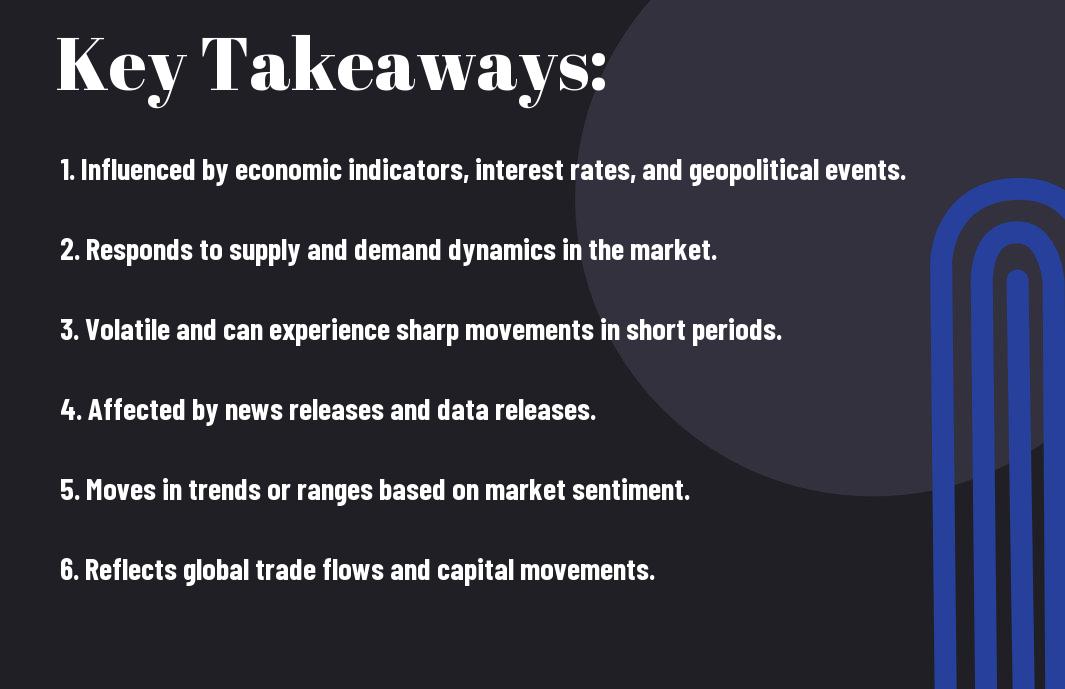Most traders are constantly trying to predict how Forex market moves in order to capitalize on potential profit opportunities. Understanding the driving forces behind currency fluctuations is imperative for success in the foreign exchange market. Factors such as geopolitical events, economic data releases, and market sentiment all play a critical role in determining the direction of currency pairs. By staying informed and analyzing these key influencers, traders can make well-informed decisions and navigate the market effectively. This blog post aims to shed light on the intricate mechanisms that govern the movements of the Forex market, empowering traders to take control of their investments.
Key Takeaways:
- Multiple Factors Influence Exchange Rates: The forex market is complex and influenced by various factors such as economic indicators, geopolitical events, and market speculation.
- Supply and Demand Drive Market Movements: Changes in supply and demand for a currency can cause fluctuations in its value. This is driven by factors like interest rates, trade balances, and economic stability.
- Market Sentiment Plays a Role: Traders’ perceptions, emotions, and biases can also impact the forex market. Positive or negative sentiment can drive buying or selling activity, leading to price movements.

Factors Influencing the Forex Market
It is necessary to understand the various factors that influence the forex market in order to make informed trading decisions. The following are some key factors that play a significant role in influencing the forex market:
- Economic Indicators
- Political Events
- Market Sentiment
- Central Bank Policies
- Geopolitical Tensions
Economic Indicators
Influencing the forex market, economic indicators such as GDP, employment rates, and inflation data can have a major impact on a country’s currency value. Traders closely monitor these indicators to gauge the overall health of an economy and make trading decisions accordingly.
Political Events
One of the key factors influencing the forex market is political events. Changes in government, elections, geopolitical tensions, and policy decisions can all impact currency value. Traders need to stay informed about these events and understand their potential implications on the forex market.
To navigate the complex world of forex trading successfully, traders must pay close attention to political events that have the potential to cause volatility in the market. By staying informed and analyzing how these events may impact currency values, traders can make more informed trading decisions and manage their risk effectively.
Market Participants and Their Impact
Central Banks
Impact: Central banks play a crucial role in the forex market. They have the power to influence currency values through monetary policy decisions. For example, when a central bank raises interest rates, it can cause the country’s currency to strengthen as investors seek higher returns. On the other hand, lowering interest rates can lead to currency depreciation to stimulate economic growth.
Individual and Institutional Traders
Banks: Individual and institutional traders, such as banks, hedge funds, and investment firms, are key participants in the forex market. They engage in buying and selling currencies to make profits from price fluctuations. Their sheer size and volume of trades can have a significant impact on exchange rates. These traders use various strategies and tools to analyze the market and make informed decisions.
Individual: Retail traders also fall into this category, although their impact is relatively smaller compared to large financial institutions. However, with the rise of online trading platforms, individual traders have become more active in the forex market. They can access the market with lower capital requirements and leverage, but this also poses risks due to high volatility and leverage.
Technical Analysis in Forex Trading
Chart Patterns and Trends
Many successful forex traders rely on technical analysis to make informed trading decisions. Chart patterns and trends play a crucial role in this analysis. Traders study patterns such as head and shoulders, double tops, and triangles to predict potential market movements. Recognizing these patterns can help traders identify entry and exit points for profitable trades.
Use of Indicators and Oscillators
Trading trends in the forex market require more than just analyzing chart patterns. Use of indicators and oscillators is another imperative aspect of technical analysis. Indicators like moving averages, Relative Strength Index (RSI), and MACD help traders confirm trends and determine market momentum. Oscillators such as Stochastic and Bollinger Bands help traders identify overbought or oversold conditions in the market.
To make informed trading decisions, traders must thoroughly understand how to interpret these indicators and oscillators. While they can provide valuable insights, over-reliance on them can lead to false signals. It is crucial for traders to use a combination of tools and not rely solely on one indicator for making trading decisions.
Fundamental Analysis in Forex Trading
Evaluating Country Economies
Your understanding of fundamental analysis in forex trading begins with evaluating country economies. Forex traders look at key economic indicators such as GDP growth, inflation rates, employment data, and interest rates to assess the health of a country’s economy. Strong economies typically have stable currencies, while weak economies may see their currency depreciate.
Impact of News and Reports
Reports of economic news and data releases can have a significant impact on forex market movements. Positive news such as strong economic growth or low unemployment rates can strengthen a country’s currency, while negative news can lead to currency depreciation. Traders need to stay informed about upcoming economic events and reports to anticipate market reactions and make informed trading decisions.
Economies can be volatile and subject to sudden changes based on geopolitical events, natural disasters, or unexpected economic data releases. Traders should exercise caution and always have risk management strategies in place to protect their investments from potential market fluctuations.
Psychological Influences on the Forex Market
Trader Psychology and Market Sentiment
On the forex market, trader psychology plays a crucial role in determining market sentiment. Trader psychology refers to the emotions and mental state of traders, which can heavily influence their trading decisions. When traders are feeling optimistic, they are more likely to buy, driving prices up. Conversely, when traders are fearful or uncertain, they may sell, causing prices to drop. Understanding and monitoring market sentiment is imperative for successful trading in the forex market.
Herd Behaviour and Its Consequences
Psychological herd behavior is a phenomenon where individuals mimic the actions of a larger group, often leading to irrational decision-making. In the forex market, herd behavior can cause prices to swing drastically as traders follow the crowd rather than their own analysis. This can create opportunities for profit, but it also poses significant risks for traders who may get caught up in market frenzy and make impulsive decisions.
Trader psychology and herd behavior are interconnected in the forex market, influencing price movements and volatility. Traders must be aware of these psychological influences and strive to maintain a rational and disciplined approach to trading to navigate the market successfully.
Risk Management in Forex
Understanding and Managing Leverage
Once again, managing leverage is crucial in forex trading. Leverage allows you to control a large position with a smaller amount of capital. While this can amplify profits, it also magnifies losses. It is important to fully understand the risks involved and use leverage wisely to avoid significant financial setbacks.
Strategies to Mitigate Forex Volatility
Forex volatility can present both opportunities and risks for traders. One strategy to mitigate volatility is diversification. By spreading your investments across different currency pairs or asset classes, you can reduce the impact of sudden price movements on your overall portfolio. Additionally, setting stop-loss orders and using hedging techniques can help protect your trades from unexpected market fluctuations.
A strategy like diversification is key to reducing the risk posed by forex volatility. By spreading your investments across different assets, you can minimize the impact of price movements on your overall portfolio. Additionally, using stop-loss orders and hedging can provide an extra layer of protection against unpredictable market conditions.
Final Words
The forex market is influenced by a multitude of factors, both fundamental and technical, which contribute to the constant fluctuations in currency prices. Understanding how the market moves is crucial for success in trading as it requires a combination of research, analysis, and strategic decision-making. By keeping abreast of global economic events, geopolitical developments, and market sentiment, traders can better anticipate the next move in the forex market. It is vital to approach trading with knowledge, discipline, and patience in order to navigate the ever-changing landscape of the forex market.
FAQ
Q: How does the forex market move?
A: The forex market moves based on the interplay of supply and demand for different currencies. When there is high demand for a currency, its value strengthens, and when there is lower demand, its value weakens. Factors such as economic indicators, geopolitical events, and market sentiment all contribute to the movement of the forex market.
Q: What are some key factors that influence the movement of the forex market?
A: Several factors can influence the movement of the forex market, including interest rates, inflation, political stability, economic performance, and market speculation. Traders analyze these factors to make informed decisions about when to buy or sell currencies.
Q: How can traders predict the direction of the forex market?
A: Traders use technical analysis, fundamental analysis, and market sentiment to predict the direction of the forex market. Technical analysis involves analyzing historical price data and chart patterns, while fundamental analysis involves examining economic indicators and news events. Market sentiment refers to the overall feeling or mood of traders towards a particular currency pair.
